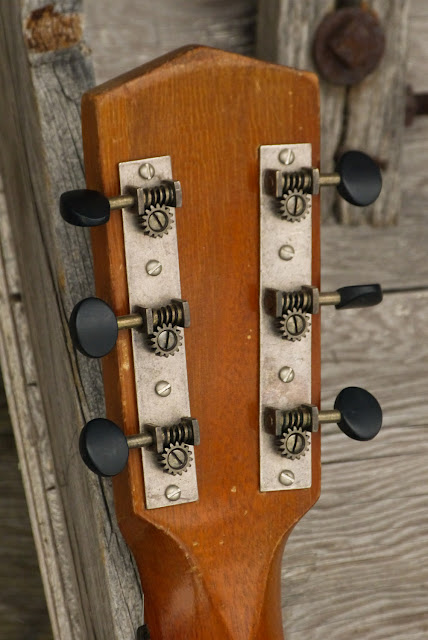1937 Gibson-made Kalamazoo KG-14 Flattop Guitar
KG-14s are pretty popular here at the shop, and this consignor-owned instrument already had a few admirers before I even did work on it. These KGs have that cool L-00 body shape but the ladder bracing gives them a barky, direct vibe that suits fingerpicking, country-blues players perfectly. I have a few more of these "in the stable" to get to, but this one was the cleanest of the bunch so I did it first.
Work included a neck reset, fret level/dress, clean-up and modification of the original bridge, a new bone saddle, new ebony endpin, a cleat to a crack on the rear, general cleaning, and a good setup. It's playing on-the-dot at 3/32" EA and 1/16" DGBE action at the 12th fret. Specs are about average for this model and it has a 14 5/8" lower bout, 1 3/4" nut width, 24 7/8" scale length, and a medium-sized V-shaped neck. The neck itself has a hair of relief on the treble side when tuned to pitch and I have an in-between set of strings on it gauged 50w, 38w, 28w, 22w, 16, 12.
Doesn't the sunburst look great alongside that firestripe pickguard? The only crack on the guitar, as mentioned, is a small hairline on the upper-bout rear that's been repaired. There's plenty of use-wear on the guitar but, overall, it looks pretty darn good.
The only replacement parts are the endpin, saddle, and these tuners -- which are StewMac Golden Era replacements that came with it (a perfect choice for this guitar). The ebony nut is original.
The fretboard and bridge are Brazilian rosewood and the board has a 12" radius and those low-ish, smaller old Gibson frets. To remove a bit of warp in the neck, I had to level and dress the frets down a little heavier near the neck joint and up at the nut, but they're still quite playable and have some decent life remaining in them.
I also added side dots in the usual Gibson pattern from the time.
The bridge came to me with a sanded, shaved-down top and a too-short, funky old saddle. I modified it to have a same-width drop-in saddle slot and made an oversized, compensated, bone saddle to fit.
I then refinished the sanded part of the bridge and antiqued it to match the look of the old finish as best as I could. Those bridge pins are original-issue!
Also note the good height left on the saddle -- and the deep slot it's in -- which means you can shave the saddle or shim it as needed depending on how the setup changes over the years.
Here's what the bridge looked like when it came in (above).
I didn't even mention woods, did I? These guitars have a solid spruce top and solid mahogany back, sides, and neck.
The back has some definite use evident in the finish.
The factory order number dates this to 1937.
Here's the cleat on the inside-rear of the guitar to shore-up that invisible (in the pics) hairline crack on the back, upper-bout. It's about 4" long and terminates at the brace just below this cleat. I could barely see it when I was working on it.
























Comments